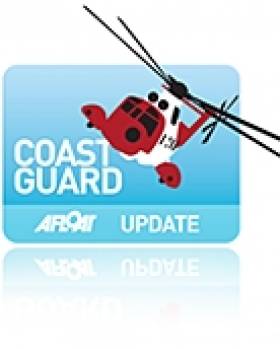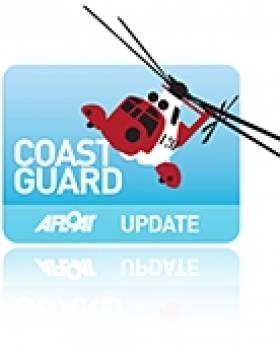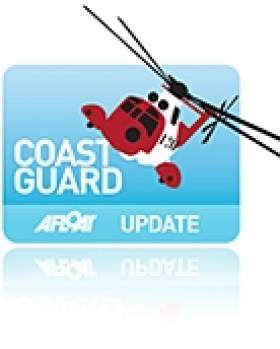Displaying items by tag: Milford Haven Coastguard
Woman Airlifted From Beach After Fall
The woman who was staying at Manorbier, had fallen near to a cave and was now on rocks to the west of the beach. Her young son (aged 11) was with her at the time along with another youngster, aged 14. The tide was coming in and there was no access out of the area, which allowed her evacuation from the area only by sea. Another member of the public who had witnessed the accident called the Coastguard for assistance.
The Tenby Coastguard Rescue Team were immediately turned out and the RNLI Tenby All weather Lifeboat with their 'Y' boat on board was also asked to launch. A rescue helicopter from RAF Chivenor was also scrambled given the inaccessibility of the area.
The weather on scene late this afternoon was southwesterly winds force 5 to 7 with moderate seas and squally showers.
From reports at the beach it was decided that conditions were too rough to effect either a cliff rescue or sea evacuation and the rescue helicopter landed on the beach and administered first aid to the woman who was in acute pain. It then took all three people off to Withybush hospital.
Nigel Yelland, Watch manager at Milford Haven Coastguard said
"The area in which the woman was exploring can be quite challenging in wet weather, and rocks can become very slippery underfoot. We're advising that as the autumnal weather becomes more hostile please wear the most appropriate clothing and footwear for the coastal areas you intend to walk, and make sure you have some method of communication to the outside world."
Two Men Rescued from Welsh Cliffs
Milford Haven Coastguard received a 999 call at 7.15 pm this evening reporting that the two men were stranded in heavy surf at the bottom of cliffs at Devil's Bridge near Broadhaven. Broadhaven Coastguard Rescue Team was requested to attend the scene, Littlehaven RNLI inshore lifeboat was requested to launch and the rescue helicopter from RAF Chivenor was scrambled.
There were heavy sea conditions on scene with strengthening winds and so a decision was made that the safest course of action would be to lower a coastguard from Broadhaven Coastguard Rescue Team to the stranded men, then bring both men back up the cliff face. This operation would be backed up by the Dale Coastguard Rescue Team and illumination of the cliff face would be provided by the lifeboat from the bottom and the helicopter overhead.
The two men, both dressed in wetsuits were recovered by the coastguard rescue team to the top of the cliff. A third man (the first informant) was also assisted back up the cliffs from the cliff path where he had been observing the ongoing situation and reporting back to Milford Haven Coastguard.
Bob Peel, Milford Haven Coastguard Watch Manager says:
"When all of the rescue assets arrived on scene, we had to make an assessment about what would be the safest way of getting the two men to safety. Due to the swell, wind conditions and height of the cliffs (about 200 ft), we decided that using the coastguard rescue team would be the best option. I am pleased to say that all three men are safe and well."
Welsh Coastguards Carry Out Two Irish Sea Evacuations
A three year old boy and a commercial seaman have both been evacuated from two separate vessels due to medical problems yesterday afternoon.
Milford Haven Coastguard was contacted at just before 4.00 pm to report that a child had been taken ill onboard the roll-on-roll-off ferry Stena Europe. The vessel was 13 nautical miles west of Strumble Head. The boy was being attended to by a doctor and two nurses onboard the ferry who, after discussion with doctors at Aberdeen Royal Infirmary, advised that the boy needed to be taken off the vessel. Rescue helicopter 122 from RAF Valley was scrambled and the boy was airlifted to Withybush Hospital.
The little boy and his family were on their way home to Ireland when the child was taken ill, says Graham Warlow, Milford Haven Coastguard Watch Manager. We wish him a speedy recovery.
At the same time that the Stena Europe was in contact with Milford Haven Coastguard, the merchant vessel Marida Melissa contacted Holyhead Coastguard to report that they had their own medical emergency onboard. One of their seafarers, an Indian national, had become ill, and after discussions with doctors it was decided that the best course of action would be to evacuate him to hospital. However, the rescue helicopter was already needed for the ill child on the ferry and so Moelfre RNLI lifeboat was requested to launch with paramedics onboard.
We dont normally use lifeboats for medical evacuations but in this case, the child had to take priority, says Barry Priddis, Holyhead Coastguard Watch Manager. When the lifeboat crew arrived at the vessel, which was anchored off Moelfre, they assessed the scene and reported back to us that they were confident that they could evacuate the ill man off of the ship safely. The man was carefully lifted on to the lifeboat then taken back into Moelfre, where he was lifted into an awaiting ambulance, then on to hospital.































































